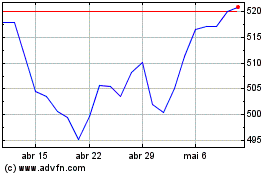What Should You Expect from the S&P 500 In 2023?
03 Janeiro 2023 - 6:56AM
Finscreener.org
Stock market investors
experienced a tough year in 2022 as the sell-off across sectors
weighed heavily on shareholder sentiment. While the
S&P 500 is down
20% from all-time highs, the tech-heavy Nasdaq
Composite index fell
more than 33% in 2022.
Let’s see what investors can
expect from the S&P 500 in 2023.
Is a market recovery on the cards?
Given historical data, the stock
market has staged a recovery in subsequent years after a drawdown
of 10% or more. In case quantitative tightening measures result in
lower inflation numbers, consumer demand should accelerate in the
second half of 2023.
The Federal Reserve lowered
interest rates soon after the markets crashed back in 2008. A lower
interest rate environment acted as a tailwind for growth stocks as
the cost of debt was minimal.
So, you could easily fund
expansion plans as well as highly accretive acquisitions. Between
2009 and 2021, growth stocks easily outpaced value
stocks.
But interest rates rose rapidly
in the last year and have spiked to 4.3%. Investors are now worried
about macroeconomic challenges ranging from inflation to supply
chain disruptions driving valuations of companies across multiple
sectors lower.
In 2022, value stocks
outperformed growth stocks by a wide margin as shareholders
gravitated towards companies with healthier balance sheets,
predictable cash flows, and reasonable multiples.
There is a good chance for value
stocks to keep outpacing growth stocks in 2023 as the Federal
Reserve is focused on keeping inflation in check even if it results
in an economic recession.
Alternatively, if the Fed pauses
rate hikes and treasury yields stabilize, growth stocks may once
again gain pace in the coming months.
Which sectors will perform well in 2023?
In the last year, higher
commodity prices, as well as the Russian invasion of Ukraine,
ensured the energy sector was the best-performing one. Oil and gas
companies managed to generate record earnings and benefit from
lofty oil prices in 2022.
Alternatively, the threat of an
upcoming recession meant bank stocks were under the pump in 2022.
Investors expect delinquency rates to surge and demand for
mortgage, consumer, and corporate loans to plummet in the near
term. Additionally, lower investment banking transactions should
drive commission and related fees toward multi-year
lows.
Apart from energy, the three
top-performing sectors in 2022 were utilities, healthcare, and
consumer staples. Each of these sectors is defensive in nature and
recession-resistant. Most of the companies in these sectors enjoy
pricing power and stable demand across market cycles.
As the U.S. economy is expected
to head into a mild recession in Q1 and Q2 of 2023, investors
should expect defensive stocks to hold much better in comparison to
broader markets. But cyclical stocks such as banking may rebound in
the second half as the economy limps towards a recovery.
In such a scenario, it makes
sense to bet on sectors levered to economic growth and moderating
inflation, such as industrials and consumer discretionary.
Basically, you need to maintain a diversified portfolio of
defensive and growth stocks as we head into 2023.
The final takeaway
There are a few headwinds
impacting stock markets in 2023, suggesting the S&P 500 will
remain volatile in the next two quarters. But we have seen that
time spent in the market is a much better strategy than timing the
markets.
SPDR S&P 500 (AMEX:SPY)
Gráfico Histórico do Ativo
De Mar 2024 até Abr 2024

SPDR S&P 500 (AMEX:SPY)
Gráfico Histórico do Ativo
De Abr 2023 até Abr 2024
